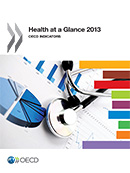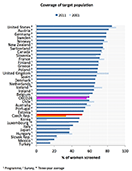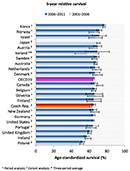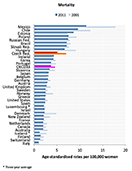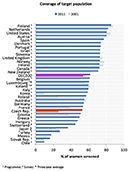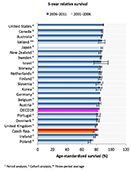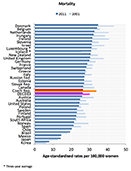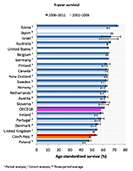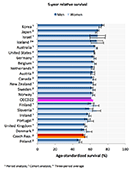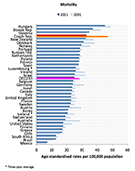OECD Health at a Glance 2013: Czech breast cancer screening programme led to an improvement of survival rates in breast cancer patients
Health at a Glance is published by OECD every two years, providing the assessment and comparison of health care in individual member countries based on clearly defined indicators. In the area of cancer care, Health at a Glance primarily focuses on three diagnoses which can be detected at early stages, and for which organised screening programmes are widely recommended: colorectal cancer, breast cancer, and cervical cancer.
Chapters dedicated to the three above-mentioned cancer types compare not only individual countries, but also the development of specific indicators over time; namely, years 2001 and 2011 (when comparing mortality rates and screening coverage), and periods 2001–2006 and 2006–2011 (when comparing 5-year relative survival).
As for the Czech Republic, the good news is that patient survival rates have significantly improved over time, while mortality rates have decreased. This trend is particularly notable in breast cancer, where the Czech Republic reports statistics similar to the OECD average (or more precisely, the average of OECD countries for which data is available). In this case, the introduction of breast screening programme in 2003 has played an important role, enabling an increase in population coverage (over 50%) and a better detection of early stages of breast cancer.
Mortality rates for colorectal cancer, however, are bad news for the Czech Republic: it ranks among OECD countries with the worst evaluation in this regard. Colorectal cancer screening programme was launched in 2009 in the Czech Republic, but has ever since struggled with a low participation rate of the target population (approximately 27% in 2013) and with a high percentage of advanced stages at the time of diagnosis (more than 50%). Unfortunately, it is not possible to compare individual countries in terms of population coverage by CRC screening, because screening methods and periodicity vary greatly in individual countries.
As regards cervical cancer, the Czech Republic also ranks under the average of evaluated OECD countries; nevertheless, a significant increase in population coverage by screening examinations (since the introduction of organised programme in 2008) raises hopes of eventual decrease in mortality rates and longer survival times.
Higher participation rates and more interest by the public in cancer screening programmes might be expected due to the introduction of personalised invitations and an extensive health education campaign in 2014. In the long term, better survival rates in cancer patients can also be expected.
More information
- Health at a Glance 2013: OECD Indicators (OECD Publishing, 2013)
Authors: Jakub Gregor, Lenka Šnajdrová, Ladislav Dušek (IBA MU)
28. 11. 2013 IBA MU


